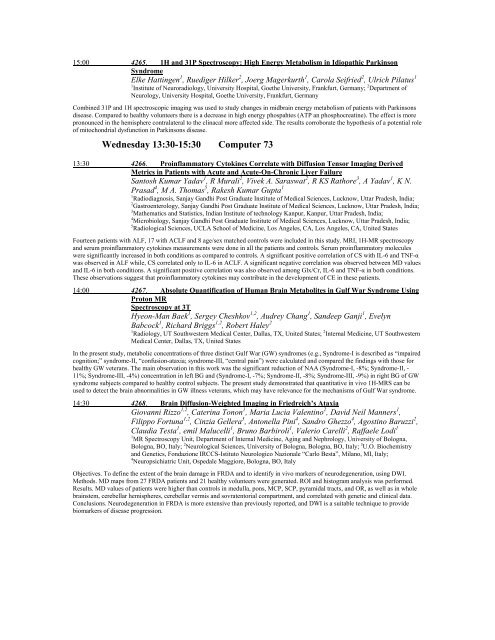Electronic Posters: Neuroimaging - ismrm
Electronic Posters: Neuroimaging - ismrm
Electronic Posters: Neuroimaging - ismrm
Create successful ePaper yourself
Turn your PDF publications into a flip-book with our unique Google optimized e-Paper software.
15:00 4265. 1H and 31P Spectroscopy: High Energy Metabolism in Idiopathic Parkinson<br />
Syndrome<br />
Elke Hattingen 1 , Ruediger Hilker 2 , Joerg Magerkurth 1 , Carola Seifried 2 , Ulrich Pilatus 1<br />
1 Institute of Neuroradiology, University Hospital, Goethe University, Frankfurt, Germany; 2 Department of<br />
Neurology, University Hospital, Goethe University, Frankfurt, Germany<br />
Combined 31P and 1H spectroscopic imaging was used to study changes in midbrain energy metabolism of patients with Parkinsons<br />
disease. Compared to healthy volunteers there is a decrease in high energy phospahtes (ATP an phosphocreatine). The effect is more<br />
pronounced in the hemisphere contralateral to the clinacal more affected side. The results corroborate the hypothesis of a potential role<br />
of mitochondrial dysfunction in Parkinsons disease.<br />
Wednesday 13:30-15:30 Computer 73<br />
13:30 4266. Proinflammatory Cytokines Correlate with Diffusion Tensor Imaging Derived<br />
Metrics in Patients with Acute and Acute-On-Chronic Liver Failure<br />
Santosh Kumar Yadav 1 , R Murali 2 , Vivek A. Saraswat 2 , R KS Rathore 3 , A Yadav 1 , K N.<br />
Prasad 4 , M A. Thomas 5 , Rakesh Kumar Gupta 1<br />
1 Radiodiagnosis, Sanjay Gandhi Post Graduate Institute of Medical Sciences, Lucknow, Uttar Pradesh, India;<br />
2 Gastroenterology, Sanjay Gandhi Post Graduate Institute of Medical Sciences, Lucknow, Uttar Pradesh, India;<br />
3 Mathematics and Statistics, Indian Institute of technology Kanpur, Kanpur, Uttar Pradesh, India;<br />
4 Microbiology, Sanjay Gandhi Post Graduate Institute of Medical Sciences, Lucknow, Uttar Pradesh, India;<br />
5 Radiological Sciences, UCLA School of Medicine, Los Angeles, CA, Los Angeles, CA, United States<br />
Fourteen patients with ALF, 17 with ACLF and 8 age/sex matched controls were included in this study. MRI, 1H-MR spectroscopy<br />
and serum proinflammatory cytokines measurements were done in all the patients and controls. Serum proinflammatory molecules<br />
were significantly increased in both conditions as compared to controls. A significant positive correlation of CS with IL-6 and TNF-α<br />
was observed in ALF while, CS correlated only to IL-6 in ACLF. A significant negative correlation was observed between MD values<br />
and IL-6 in both conditions. A significant positive correlation was also observed among Glx/Cr, IL-6 and TNF-α in both conditions.<br />
These observations suggest that proinflammatory cytokines may contribute in the development of CE in these patients.<br />
14:00 4267. Absolute Quantification of Human Brain Metabolites in Gulf War Syndrome Using<br />
Proton MR<br />
Spectroscopy at 3T<br />
Hyeon-Man Baek 1 , Sergey Cheshkov 1,2 , Audrey Chang 1 , Sandeep Ganji 1 , Evelyn<br />
Babcock 1 , Richard Briggs 1,2 , Robert Haley 2<br />
1 Radiology, UT Southwestern Medical Center, Dallas, TX, United States; 2 Internal Medicine, UT Southwestern<br />
Medical Center, Dallas, TX, United States<br />
In the present study, metabolic concentrations of three distinct Gulf War (GW) syndromes (e.g., Syndrome-I is described as “impaired<br />
cognition;” syndrome-II, “confusion-ataxia; syndrome-III, “central pain”) were calculated and compared the findings with those for<br />
healthy GW veterans. The main observation in this work was the significant reduction of NAA (Syndrome-I, -8%; Syndrome-II, -<br />
11%; Syndrome-III, -4%) concentration in left BG and (Syndrome-I, -7%; Syndrome-II, -8%; Syndrome-III, -9%) in right BG of GW<br />
syndrome subjects compared to healthy control subjects. The present study demonstrated that quantitative in vivo 1H-MRS can be<br />
used to detect the brain abnormalities in GW illness veterans, which may have relevance for the mechanisms of Gulf War syndrome.<br />
14:30 4268. Brain Diffusion-Weighted Imaging in Friedreich’s Ataxia<br />
Giovanni Rizzo 1,2 , Caterina Tonon 1 , Maria Lucia Valentino 2 , David Neil Manners 1 ,<br />
Filippo Fortuna 1,2 , Cinzia Gellera 3 , Antonella Pini 4 , Sandro Ghezzo 4 , Agostino Baruzzi 2 ,<br />
Claudia Testa 1 , emil Malucelli 1 , Bruno Barbiroli 1 , Valerio Carelli 2 , Raffaele Lodi 1<br />
1 MR Spectroscopy Unit, Department of Internal Medicine, Aging and Nephrology, University of Bologna,<br />
Bologna, BO, Italy; 2 Neurological Sciences, University of Bologna, Bologna, BO, Italy; 3 U.O. Biochemistry<br />
and Genetics, Fondazione IRCCS-Istituto Neurologico Nazionale “Carlo Besta”, Milano, MI, Italy;<br />
4 Neuropsichiatric Unit, Ospedale Maggiore, Bologna, BO, Italy<br />
Objectives. To define the extent of the brain damage in FRDA and to identify in vivo markers of neurodegeneration, using DWI.<br />
Methods. MD maps from 27 FRDA patients and 21 healthy volunteers were generated. ROI and histogram analysis was performed.<br />
Results. MD values of patients were higher than controls in medulla, pons, MCP, SCP, pyramidal tracts, and OR, as well as in whole<br />
brainstem, cerebellar hemispheres, cerebellar vermis and sovratentorial compartment, and correlated with genetic and clinical data.<br />
Conclusions. Neurodegeneration in FRDA is more extensive than previously reported, and DWI is a suitable technique to provide<br />
biomarkers of disease progression.
















